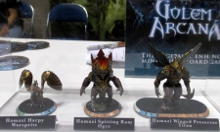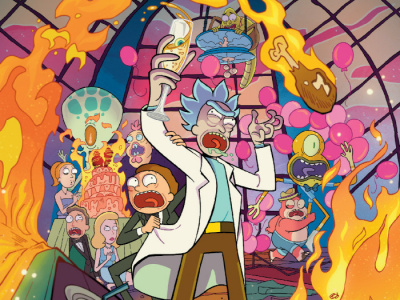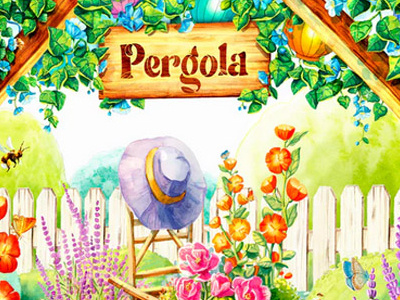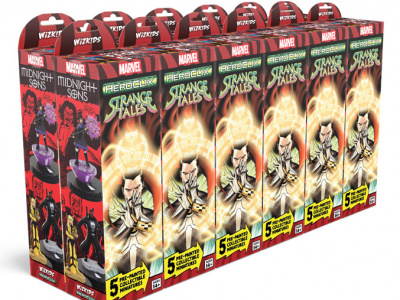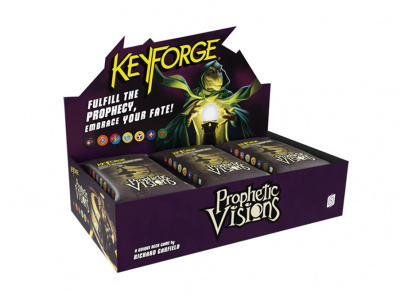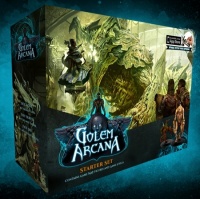 Harebrained Schemes co-founder and legendary game designer Jordan Weisman (Shadowrun, BattleTech, MechWarrior, Mage Knight, HeroClix) has designed a new game that bridges the physical and digital worlds. Golem Arcana is played on terrain with miniatures aided by a tablet or smartphone. We spoke to Weisman, co-founder of Harebrained Schemes, at Gen Con (occasionally aided by Harebrained producer and metrics analyst Brian Poel). In Part 3, we talk about the Kickstarter, the product configuration, and the company behind the game. In Part 1, Weisman talked about the game play and the technology. In Part 2, Weisman gave more game details and talked about what retailers can expect.
Harebrained Schemes co-founder and legendary game designer Jordan Weisman (Shadowrun, BattleTech, MechWarrior, Mage Knight, HeroClix) has designed a new game that bridges the physical and digital worlds. Golem Arcana is played on terrain with miniatures aided by a tablet or smartphone. We spoke to Weisman, co-founder of Harebrained Schemes, at Gen Con (occasionally aided by Harebrained producer and metrics analyst Brian Poel). In Part 3, we talk about the Kickstarter, the product configuration, and the company behind the game. In Part 1, Weisman talked about the game play and the technology. In Part 2, Weisman gave more game details and talked about what retailers can expect.What’s the status of the Kickstarter?
Weisman: The Kickstarter is going to go live September 10th.
When is it going to be released to backers and when is it going to be a trade release?
Weisman: Trade release and backer release will be the same time, and right now we’re looking at that being June of next year.
You mentioned that there are starter packs and then these individual Colossus figures. Are there going to be booster-type products?
Weisman: Well, it’s not a blind purchase. It’s an exposed purchase. So figures would be sold individually, at $10, $12, and $15. Or in sets. And one thing we’re trying to get from retailers at the show is, what would they like? Would they rather have these as individually packaged figures or would they rather have one set for $40 or as individual figures that would add up to $47 dollars? So we have time between now and June to get feedback from retailers, because we want to make sure we’re packaging it in a way that retailers are going to like.
Is the starter enough for two people to play or just one?
Weisman: Two people. You share the stylus, and you have a three on three army to start.
Is there a maximum size for the army?
Weisman: We don’t think so yet.
Only limited by your imagination and your pocketbook.
Weisman: You are exactly right. And with "save game" it’s not like you’re limited by time anymore either.
You also said you’re going to sell additional terrain?
Weisman: Yes. We’ll sell additional terrain packs at retail as well. Right now it looks like a set of nine tiles would be in the neighborhood of $15. We’re still working on that.
So that would give you a different setting to play in?
Weisman: That’s right. So you can expand the play field and use the different types of terrain that come in it.
You’ve worked on a couple of games that have the idea of interacting the physical and the digital world, trying to enhance play using a digital component. What’s different about this one, and why do you think it will be successful?
Weisman: You are certainly right. This has been a crusade I’ve been on for a number of years, to get the physical and digital to mix. And the reason is because I love nothing better than being at the same table, that face to face play. I don’t want everything to go digital. I keep wanting to find that right alchemy. So what’s different about this one? It actually works!
Sometimes it just takes iteration; keep working it till you get it. It was finding an input technology that was so lightweight that it didn’t overburden the game. Here, the fact that you normally point to a figure and say "this is the guy who I’m using" is now the same as taking the stylus and pointing to the guy and saying "this is the guy I’m using." There is no additional entry; it’s just the same pointing gesture. I think that was the key, finding something that really made it that smooth of a U.I.
Poel: Plus, smartphones, and data-connected smartphones, are so pervasive that you can safely say that the target market is going to have access to this.
Looks like it’s all designed, why are you waiting until June to ship?
Weisman: This looks like it, but it isn’t. This is a demo. We have so much more depth that we want to add to this, we have to do all of the server side stuff. We have to do all of the actual--those are all hacked together prototypes, we have to do the actual electro-engineering to get it into production format, besides having to produce all the figures and the boards and everything else. I want to make sure we have the time to do it right. Luckily, Shadowrun was the first big software title to actually deliver on Kickstarter. I don’t want to screw that up by not delivering the next one.
Give yourself a long runway.
Weisman: Yeah. Especially when you’re developing physical goods, you want to have time to make multiple iterations to make sure it’s really right.
What’s the Kickstarter goal going to be?
Weisman: We’re looking at about a $600,000 starting goal and going up from there.
For the initial launch in June, is that just going to be the starter or will there be some of the figures with it?
Weisman: There will be a number of single figures. Depending on how the Kickstarter goes, there will be a lot for the initial set. If we’re lucky, they may unlock a lot of figures and then it will be too many to release at retail at one time.
Poel: Plus the world itself has a lot of different factions and pantheons that are in our back pocket to roll out as the game succeeds and we’ll introduce new play styles and new mechanics.
Weisman: We’re starting with three factions and there is a fourth that can be unlocked via the Kickstarter.
What is Harebrained Schemes?
Weisman: Harebrained Schemes started about three years ago and we started doing mobile apps. We did one called Crimson: Steam Pirates, which was one of Apple’s Games of the Year. Then we did one called Strikefleet Omega, which was one of Android’s Games of the Year.
Then last year we did a Kickstarter to do Shadowrun Returns, and raised a bunch of money from fans to do a computer RPG for Shadowrun, which we just released last month and is going very, very well.
Did you do the gameplay and the narrative in the universe yourself?
Weisman: Yeah, I start it all, and then talented people come in and finish it.
Click here to go back to Part 1.



